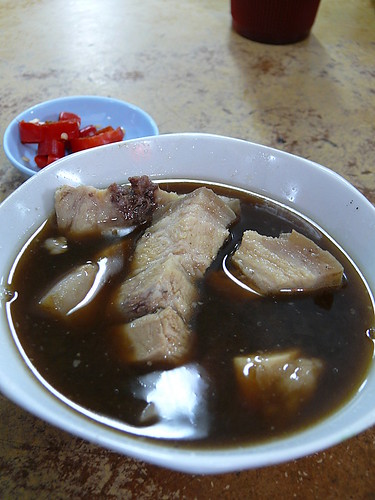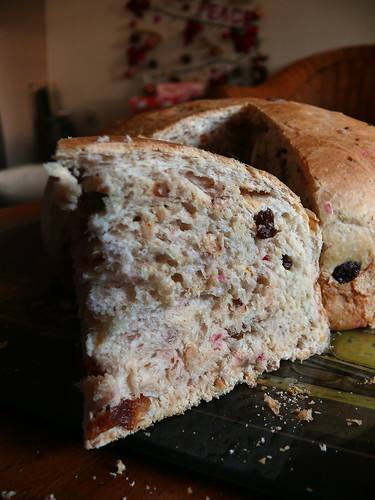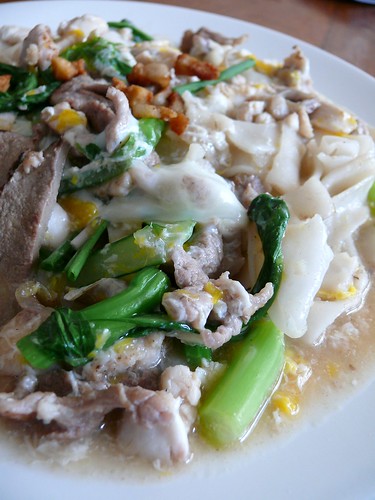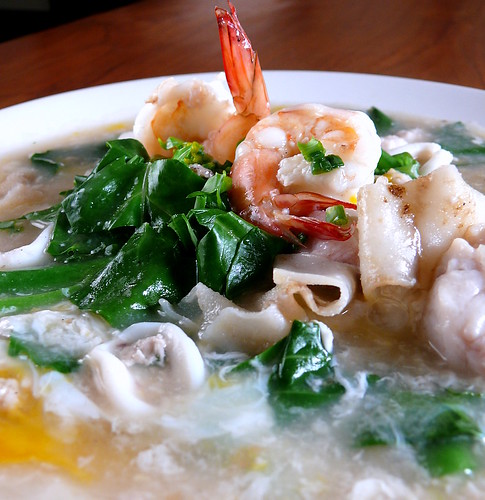 Cheong fun without filling
Cheong fun without fillingFlat rice noodles or
kuey tiao (
ho fun in Cantonese) are called as such to distinguish them from ordinary rice noodles, which are usually thin and cylindrical, and unlike in China where they are fresh, the rice noodles we get here are dried. Flat rice noodles are popular because they are slippery-smooth and soft with a slight bite. I prefer flat rice noodles to fresh yellow oily wheat noodles because I hate the flavor of the lye said to be an ingredient of yellow oily noodles. Lye is a corrosive chemical (NaOH--sodium hyroxide) found in soap and household cleaning detergents. Still hungry for that bowl of oily yellow noodles?
Flat rice noodles are not that pure too. Boric acid as a preservative is used in commercial rice noodles such as flat rice noodles and the real-fun-to-eat noodles called
lao su fen meaning 'mouse tail noodles', which really look more like large worms than tails to me. Many years ago a dozen or more primary school children in Malaysia died after a lunch of mouse tail noodles that had too much boric acid.
I stopped eating
kuey tiao about 10 years ago after a shocking discovery. A friend brought me to a noodles factory in Kolombong that makes, among others,
cheong fun (rice rolls) and I started serving that for snacks for my cell group. One Saturday, I went to the factory late, around 2 pm, when they were closing, and I noticed bags of noodles stacked on some tables and I asked the girl working there what would happen to the unsold noodles. She nonchalantly replied that the noodles can stay on the tables through the weekend without refrigeration. I just couldn't believe that in our hot weather noodles can stay fresh for more than 24 hours. Just how much boric acid is in the noodles? Boric acid reportedly causes infertility (damages the testes--ouch) and damage to internal organs. Plastics too are out to make sure you don't pass your genes to the next generation. So why do you think infertility is on the rise?
I happened to watch a Korean program last night and was so glad I did. Have you ever wondered how they peel the skins off canned mandarin oranges and orange pulp in orange juice and canned fruits such as peaches? Orange sections are soaked and boiled in hydrochloric acid (HCL) and peaches are soaked in NaOH. Of course, they neutralise the HCL and NaOH with base and acids respectively, and so by law need not reveal that the canning process includes contamination with these chemicals. And besides the treatment by these chemicals, the canned fruits are subject to heat, which destroys Vitamin C and also changes their color so coloring is added. Then because these fruits are picked when still unripe, they add tons of sugar to sweeten them. The result is perfect, processed fruits with very little nutritional value and lots of sugar/calories. In fact, there's so much sugar that 1 large can of mandarins contain the same calories as 13 fresh mandarins! Still like those canned peaches and cherries?
So, given all that, bless you if you still eat flat noodles and yellow oily noodles. But we, the mothers/girlfriends/conscientious cooks can do something about processed food. We can cook from scratch. I truly believe that we should go back to those unprocessed food days.
This is where food bloggers come in. In this case, Zurin of
Cherry On A Cake. Zurin recently posted a recipe on home-made
kuey tiao. Thanks Zurin! My
kuey tiao turned out so successful that I made a batch for afternoon snack and another for dinner, and I suspect I'll make another batch before I post this because I need to take some pictures of the how-to.
Other than
kuey tiao, I also made some
cheong fun (rice rolls) by increasing the amount of wheat starch to give the noodles more bite. You can adjust the amount of flours to get the texture you want.
 Flat Rice Noodles
Flat Rice Noodles150 g or 1 1/2 cups rice flour
1 1/2 T wheat starch (
tang mien flour)*
2 T cornflour
400 ml or 1 3/4 cups water
1 T veg oil
1/4 t salt (I reduced this from 1/2 t)
* increasing this to 2 T will give the noodles a stronger bite.
1. Mix all the above ingredients well into a thin batter and let it rest for an hour. Do not be impatient like me. I tried steaming 10 minutes after mixing the batter and the rice pancake was soft and sticky. Just before the hour's up, get ready a steaming wok of water.
2. Ladle into a greased pan and steam 3-5 minutes, depending on the thickness and size of your pan. I used a tart pan with a removable base which was stupid because the batter ran through the sides into the water. I think a non-stick cake pan's best but you still have to oil it the first time. It's helpful to remember the amount of batter and size of your cake tin so you can get the same thickness for each pancake.
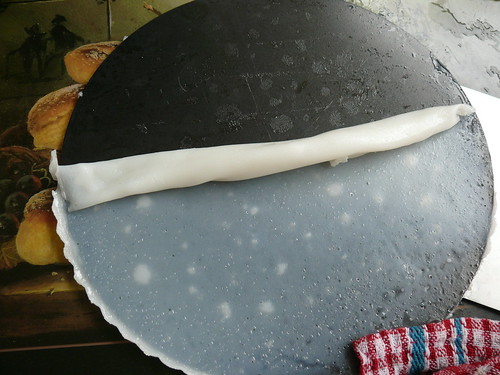
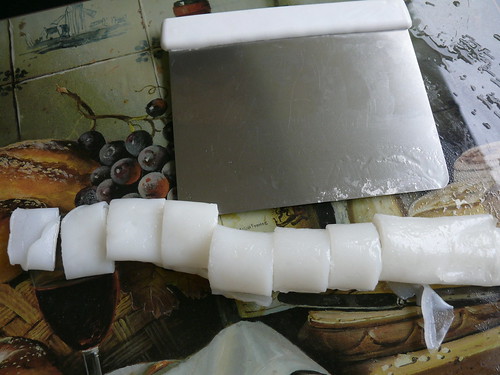
3. For
kuey tiao, make thinner pancakes. When cool enough to handle, peel it off the pan, roll it up loosely (no need for neatness) and cut it with an oiled pastry cutter into 1 cm pieces. Unravel the flat rice noodles by fluffing them with your hands gently.
4. For
unfilled cheong fun (as versus
cheong fun with fillings, which should be paper-thin), you can make thicker pancakes and roll the pancakes snugly, then cut into 2 cm slices. Do not unravel. Top the
cheong fun with:
hoisin sauce (Lee Kum Kee brand is good), Maggi soy sauce, sweet chili sauce, toasted sesame seeds and chopped spring onions.



